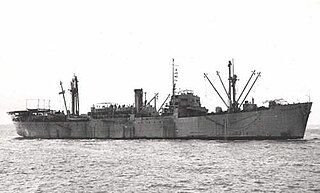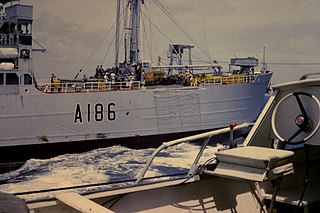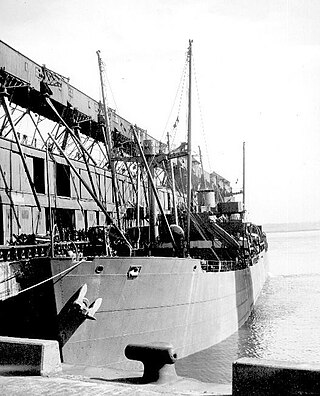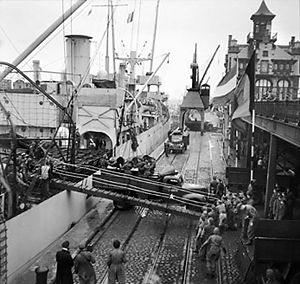
Kingston is a city in Ontario, Canada, on the northeastern end of Lake Ontario. It is at the beginning of the St. Lawrence River and at the mouth of the Cataraqui River, the south end of the Rideau Canal. Kingston is midway between Toronto, Ontario, and Montreal, Quebec, and is also near the Thousand Islands, a tourist region to the east, and the Prince Edward County tourist region to the west. Kingston is nicknamed the "Limestone City" because it has many heritage buildings constructed using local limestone.

The Victory ship was a class of cargo ship produced in large numbers by North American shipyards during World War II to replace losses caused by German submarines. They were a more modern design compared to the earlier Liberty ship, were slightly larger and had more powerful steam turbine engines, giving higher speed to allow participation in high-speed convoys and make them more difficult targets for German U-boats. A total of 531 Victory ships were built in between 1944 and 1946.

Liberty ships were a class of cargo ship built in the United States during World War II under the Emergency Shipbuilding Program. Although British in concept, the design was adopted by the United States for its simple, low-cost construction. Mass-produced on an unprecedented scale, the Liberty ship came to symbolize U.S. wartime industrial output.

RFA Fort Victoria is a Fort-class combined fleet stores ship and tanker of the Royal Fleet Auxiliary of the United Kingdom tasked with providing ammunition, fuel, food and other supplies to Royal Navy vessels around the world. She is now the only member of her class.

RFA Fort Charlotte (A236) was a stores issuing ship of the Royal Fleet Auxiliary.

RFA Fort Duquesne (A229) was an air stores ship of the Royal Fleet Auxiliary a Fort type ship.
RFA Fort Langley (A230) was a stores ship of the Royal Fleet Auxiliary.

RFA Fort Rosalie (A186) was an armament stores carrier of the Royal Fleet Auxiliary.
SS Fort La Montee was a North Sands-class cargo ship, built during the Second World War and seeing use as an ammunition transport for the Allies in the Mediterranean Theatre.

Park ships were merchant steamships constructed for Canada’s Merchant Navy during the Second World War. Park ships and Fort ships were the Canadian equivalent of the American Liberty ships. All three shared a similar design by J.L. Thompson and Sons of Sunderland, England. Fort ships had a triple expansion steam engine and a single screw propeller. Fort ships were ships transferred to the British government and the Park ships were those employed by the Canadian government, both had the similar design. Park ships were named after local and National Parks of Canada. A few Park ships were launched as "Camp ships", named after Canada military camps, but were quickly renamed after Parks. Jasper Park was the first Park ship lost to enemy attack, in the Indian Ocean after a torpedo attack from U-177 in the Indian Ocean, South of Durban, South Africa.

The Ocean ships were a class of sixty cargo ships built in the United States by Todd Shipyards Corporation during the Second World War for the British Ministry of War Transport under contracts let by the British Purchasing Commission. Eighteen were lost to enemy action and eight to accidents; survivors were sold postwar into merchant service.
SS Fort Athabaska was a Canadian-owned Fort ship, sunk while under British naval use in 1943. With the heavy demand for British cargo ships it was given to British naval forces.
SS Fort Abitibi was a North Sands-type Fort ship of 7,125 GRT measuring 440.5 feet (134.3 m) long with a beam of 57.2 feet (17.4 m).

The Fort ships were a class of 198 cargo ships built in Canada during World War II for use by the United Kingdom. They all had names prefixed with "Fort" when built. The ships were in service between 1942 and 1985, with two still listed on shipping registers until 1992. A total of 53 were lost during the war due to accidents or enemy action. One of these, Fort Stikine, was destroyed in 1944 by the detonation of 1,400 tons of explosive on board her. This event, known as the Bombay Explosion, killed over 800 people and sank thirteen ships. Fort ships were ships transferred to the British Government and the Park ships were those employed by the Canadian Government, both had the similar design.

The SS Luray Victory was the seventeenth Victory ship, a new 10,500 ton class ship built during World War II. The California Shipbuilding Company built the ship under the Emergency Shipbuilding program. She was launched on May 11, 1944, and completed on June 26, 1944. The ship’s United States Maritime Commission designation was VC2-S-AP3, hull number 17 (V-17). The SS Luray Victory served in the Pacific Ocean during World War II and was operated by the Black Diamond Steamship Company.

SS Jasper Park was a Park ship freighter, built in 1942. She was sunk by torpedo from German submarine U-177 on 6 July 1943, the first Park ship lost to enemy action. She was completed on 24 September 1942, by the company Davie Shipbuilding in Lauzon, Quebec. Her hull number is 537. Davie Shipbuilding is now called Chantier Davie Canada Inc. The ship was owned by the Park Steamship Company, which was owned by Canada's Federal government. The government had built 400 vessels during World War II. Built as a merchant steamship constructed for Canada’s Merchant Navy in 1942. She was named after Jasper National Park in the Canadian Rockies in the province of Alberta, Canada.

Taber Park was a Park ship freighter, built in 1944. She was sunk by torpedo from a German submarine U-boat on March 13, 1945. She was completed on 28 August 1944, by the company Foundation Maritime, in the Pictou Shipyard in Pictou County, Nova Scotia, Canada. Her hull # is 16. The ship was owned by the Park Steamship Company, which was owned by Canada's Federal government. The government had built 400 vessels during World War II. Built as a merchant steamship constructed for Canada’s Merchant Navy in 1944. She was named after an actual park in Canada, in the province of Alberta. She was operated for the Government by Canada Shipping Company. Taber Park should not to be taken as the Tabor Park a Norway cargo ship that was torpedoed, shelled and sunk in the Indian Ocean on 9 March 1943.

World War II United States Merchant Navy was the largest civilian Navy in the world, which operated during World War II. With the United States fighting a world war in all the world oceans, the demand for cargo and fuel was very high. Cargo and fuel was needed around the world for the United States Navy, United States Army, United States Marine Corps, United States Army Air Forces, United States Coast Guard and the support of the allied nations of the United States. American steamship companies chartered ships from the Maritime Commission and War Shipping Administration to meet the demand. Many United States Merchant Marine ships were newly built in the Emergency Shipbuilding Program, other ships were older World War I ships that were put back in service, or private ships acquired under Emergency war requisitions. The Merchant Navy operated in the Pacific War and European war. Over 200 US Merchant ships took part in the D-day Normandy landings. To make a Normandy breakwater Harbor, called Mulberry harbour, 33 merchant ships were sunk 1,000 yards from shore. Some of the ghosts merchant ships used were damaged and others were deemed too old.

Sieling & Jarvis Inc. was a shipping company that operated tanker ships and some cargo ships. Sieling & Jarvis was started by David B. Jarvis and Dick Sieling in New York City. Later David B. Jarvis was the company president and later became the sole owner of Sieling & Jarvis Inc. Mr. Sieling was the vice president and a partner in Sieling & Jarvis. Sieling & Jarvis supported the World War II effort by operating United States owned ships.













